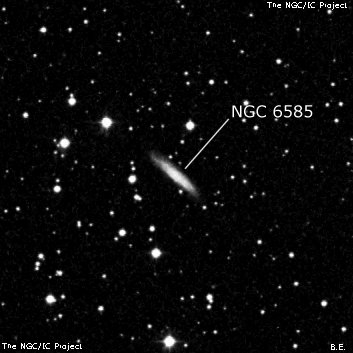
Edward Swift, the 16 year-old son of Lewis, discovered NGC 6585 = Sw. IX-87 on 25 May 1887. He reported, "eeeF; pS; E; eee diff; between several bright stars." The Swift's position is 3' north of UGC 11159 (typical error) and the description is applicable as several fairly bright stars surround the galaxy. The discovery was communicated directly to Dreyer and published in 1890 after the NGC. Bigourdan measured an accurate postion on 14 Jul 1890. Howe also measured a good position in 1899-00 and noted "the elongation is at 45°, the nebula being 1.0' or more in length, and brighter in the middle. It appeared to have a backbone or central stripe of greater brightness than the rest."
400/500mm - 17.5" (8/1/89): fairly faint, fairly small, edge-on SW-NE, weak concentration. Located within a group of ten mag 10-12 stars including a mag 11 star 1.5' N and a mag 10 star 2.5' NE that is collinear with the major axis.
600/800mm - 24" (9/6/18): fairly bright, fairly large, edge-on 6:1 SW-NE, ~1.5'x0.25', brighter core, irregular surface brightness. The mottled appearance strongly suggested a dusty surface and this was later verified on the PanSTARRS image. Nestled in a striking location, surrounded by a group of brighter stars to the north, east and south [extending ~9'x4' N-S].
Notes by Steve Gottlieb